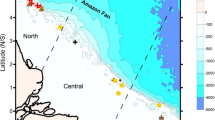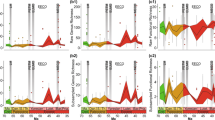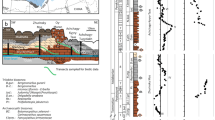Abstract
Recovery from the devastating Permian–Triassic mass extinction about 252 million years ago is usually assumed to have spanned the entire 5 million years of the Early Triassic epoch1,2. The post-crisis interval was characterized by large-scale fluctuations of the global carbon cycle and harsh marine conditions, including a combination of ocean acidification, euxinia, and fluctuating productivity3. During this interval, metazoan-dominated reefs are thought to have been replaced by microbial deposits that are considered the hallmark of the Early Triassic4,5,6,7. Here we use field and microscopic investigations to document Early Triassic bioaccumulations and reefs from the western USA that comprise of various sponges and serpulids associated with microbialites and other eukaryotic benthic organisms. These metazoan-rich reefs were formed only 1.5 million years after the extinction, in contrast to previous suggestions of a much delayed recovery of complex benthic communities. We conclude that the predominance of microbial reefs following the mass extinction is restricted to short intervals of the earliest Triassic. We suggest that metazoan reef building continued throughout the Early Triassic wherever permitted by environmental conditions.
This is a preview of subscription content, access via your institution
Access options
Subscribe to this journal
Receive 12 print issues and online access
$259.00 per year
only $21.58 per issue
Buy this article
- Purchase on Springer Link
- Instant access to full article PDF
Prices may be subject to local taxes which are calculated during checkout



Similar content being viewed by others
References
Erwin, D. H. Extinction. How life on Earth Nearly Ended 250 Million Years Ago (Princeton Univ. Press, 2006).
Galfetti, T. et al. Timing of the Early Triassic carbon cycle perturbations inferred from new U–Pb ages and ammonoid biochronozones. Earth Planet. Sci. Let. 258, 593–604 (2007).
Payne, J. L. et al. Large perturbations of the carbon cycle during recovery from the end-Permian extinction. Science 305, 506–509 (2004).
Baud, A., Richoz, S. & Pruss, S. The Lower Triassic anachronistic carbonate facies in space and time. Global Planet. Change 55, 81–89 (2007).
Pruss, S. B., Bottjer, D. J., Corsetti, F. A. & Baud, A. A global marine sedimentary response to the end-Permian mass extinction: Examples from southern Turkey and the western United States. Earth Sci. Rev. 78, 193–206 (2006).
Woods, A. D. Anatomy of an anachronistic carbonate platform: Lower Triassic carbonates of the southwestern United States. Aust. J. Earth Sci. 56, 825–839 (2009).
Woods, A. D. & Baud, A. Anachronistic facies from a drowned Lower Triassic carbonate platform: Lower member of the Alwa Formation (Baïd Exotic), Oman Mountains. Sediment. Geol. 209, 1–14 (2008).
Brayard, A. et al. Good genes and good luck: Ammonoid diversity and the end-Permian mass extinction. Science 325, 1118–1121 (2009).
Orchard, M. J. Conodont diversity and evolution through the latest Permian and Early Triassic upheavals. Palaeogeogr. Palaeoclimatol. Palaeoecol. 252, 93–117 (2007).
Weidlich, O., Kiessling, W. & Flügel, E. Permian–Triassic boundary interval as a model for forcing marine ecosystem collapse by long-term atmospheric oxygen drop. Geology 31, 961–964 (2003).
Payne, J. L., Lehrmann, D. J., Christensen, S., Wei, J. & Knoll, A. Environmental and biological controls on the initiation and growth of a Middle Triassic (Anisian) reef complex on the Great Bank of Guizhou, Guizhou Province, China. Palaios 21, 325–343 (2006).
Flügel, E. in Phanerozoic Reef Patterns Vol. 72 (eds Kiessling, W., Flügel, E. & Golonka, J.) 391–463 (SEPM Special26 Publication Series, Society for Sedimentary Geology, 2002).
Pisera, A., Rigby, J. K. & Bylund, K. G. Lower Triassic hexactinellid sponges from the Confusion Range, western Utah. BYU Geol. Stud. 41, 139–148 (1996).
Rigby, J. K. & Gosney, T. C. First reported Triassic lyssakid sponges from North America. J. Paleontol. 57, 787–796 (1983).
Pruss, S. B., Payne, J. L. & Bottjer, D. J. Planucopsis bioherms: The first metazoan buildups following the end-Permian mass extinction. Palaios 22, 17–23 (2007).
Griffin, J. M., Marenco, P. J., Fraiser, M. L. & Clapham, M. E. 2010 GSA Annual Meeting Paper no. 21–16 (Denver, 2010).
Szulc, J. in The Global Triassic Vol. 41 (eds Lucas, S. G. & Spielmann, J. A.) (New Mexico Museum of Natural History, 2007).
Baud, A., Brandner, R. & Donofrio, D. A. The Sefid Kuh Limestone—A late Lower Triassic carbonate ramp (Aghdarband, NE-Iran). Abh. Geol. B.–A. 38, 111–123 (1991).
Baud, A. et al. Lower Triassic bryozoan beds from Ellesmere Island, High Arctic, Canada. Polar Res. 27, 428–440 (2008).
Riding, R. Microbial carbonate abundance compared with fluctuations in metazoan diversity over geological time. Sediment. Geol. 185, 229–238 (2006).
Senowbari-Daryan, B., Caruthers, A. H. & Stanley, G. D. Jr The First Upper Triassic Silicified Hypercalcified Sponges from the Alexander Terrane, Gravina Island and Keku Strait, Southeast Alaska. J. Paleontol. 82, 344–350 (2008).
Pruss, S. B. & Bottjer, D. J. The reorganization of reef communities following the end-Permian mass extinction. C. R. Palevol 4, 553–568 (2005).
Schubert, J. K. & Bottjer, D. J. Early Triassic stromatolites as post-mass extinction disaster forms. Geology 20, 883–886 (1992).
Twitchett, R. J. & Barras, C. J. The Application of Ichnology to Palaeoenvironmental and Stratigraphic Analysis 397–418 (Geological Society Special Publication, 2004).
Brunton, F. R. & Dixon, O. A. Siliceous sponge-microbe biotic associations and their recurrence through the Phanerozoic as reef mound constructors. Palaios 9, 370–387 (1994).
Wood, R. Palaeoecology of a post-extinction reef: Famennian (Late Devonian) of the Canning Basin, North-western Australia. Palaeontology 47, 415–445 (2004).
Delecat, S. & Reitner, J. Sponge communities from the Lower Liassic of Adnet (Northern Calcareous Alps, Austria). Facies 51, 385–404 (2005).
Stanley, G. D. Jr The evolution of modern corals and their early history. Earth Sci. Rev. 60, 195–225 (2003).
Knoll, A. H., Bambach, R. K., Payne, J. L., Pruss, S. & Fischer, W. W. Paleophysiology and end-Permian mass extinction. Earth Planet. Sci. Lett. 256, 295–313 (2007).
O’Dogherty, L., Carter, E. S., Š Goričan, Š. & Dumitrica, P. Triassic radiolarian biostratigraphy. Geol. Soc. Lond. Spec. Publ. 334, 163–200 (2010).
Acknowledgements
This article is a contribution to the teams FED and SEDS of the UMR CNRS 5561 (A.B., E.V.), and teams VP and BFFD of the UMR CNRS 5276 (N.O., G.E.). This work was funded by the Région Bourgogne, the FRB, the INSU Interrvie (A.B., G.E., N.O., E.V.), and supported by the Swiss NSF project 200020-113554 (H.B.). R. Bourillot, M. Hautmann, P. A. Hochuli, J. Vacelet, and D. Vachard are thanked for discussions. G. D. Stanley is also thanked for his taxonomic advice regarding organism determinations and for his contribution in improving an earlier version of the manuscript. The authors appreciate access to lands managed by the BLM of the US Department of Interior and the US Forest Service (Fishlake National Forest) of the US Department of Agriculture.
Author information
Authors and Affiliations
Contributions
Fieldwork was carried out by all authors. Thin section studies were performed by E.V., A.B. and N.O. Ammonoid determinations: A.B. and H.B. Conodont determinations: N.G. Manuscript was written by A.B., E.V., N.O, G.E., H.B. with comments on contents from all authors.
Corresponding author
Ethics declarations
Competing interests
The authors declare no competing financial interests.
Supplementary information
Supplementary Information
Supplementary Information (PDF 14291 kb)
Rights and permissions
About this article
Cite this article
Brayard, A., Vennin, E., Olivier, N. et al. Transient metazoan reefs in the aftermath of the end-Permian mass extinction. Nature Geosci 4, 693–697 (2011). https://doi.org/10.1038/ngeo1264
Received:
Accepted:
Published:
Issue Date:
DOI: https://doi.org/10.1038/ngeo1264
This article is cited by
-
Environmental crises at the Permian–Triassic mass extinction
Nature Reviews Earth & Environment (2022)
-
Reconstruction of tectonically disrupted carbonates through quantitative microfacies analyses: an example from the Middle Triassic of Southern Italy
Facies (2021)
-
Permian–Triassic mass extinction pulses driven by major marine carbon cycle perturbations
Nature Geoscience (2020)
-
Palaeoecology of Late Ladinian (Middle Triassic) benthic faunas from the Schlern/Sciliar and Seiser Alm/Alpe di Siusi area (South Tyrol, Italy)
PalZ (2019)
-
The Mesozoic maximum of 87Sr/86Sr ratio: a critical turning point after the end-Permian mass extinction
Carbonates and Evaporites (2019)



